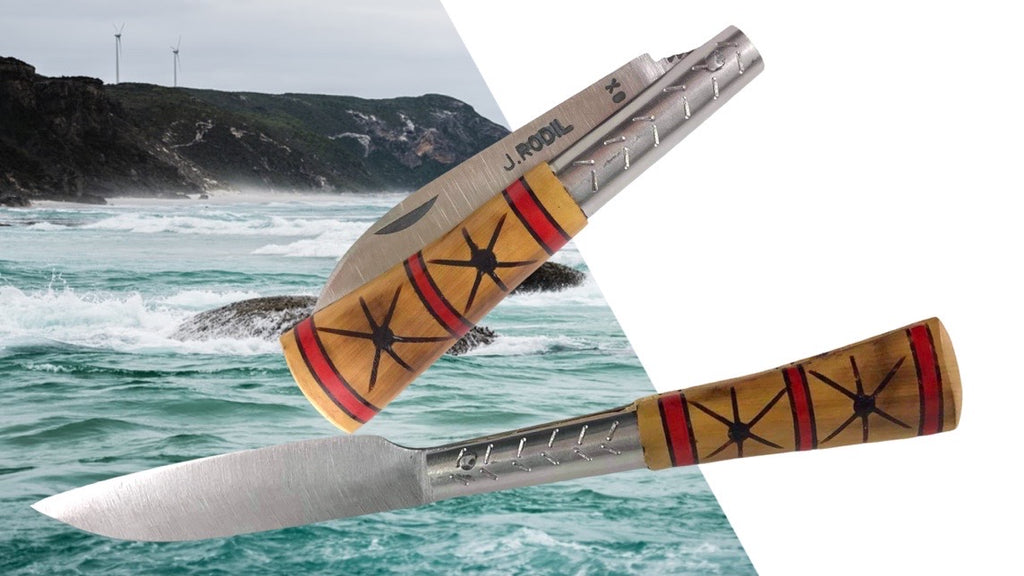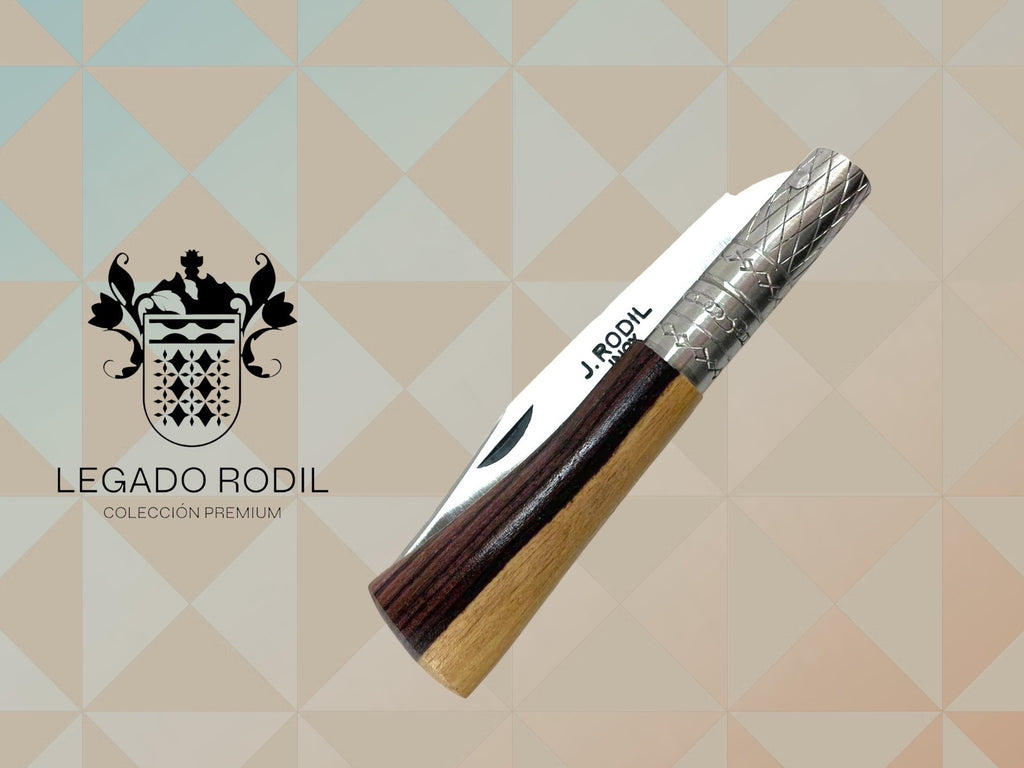What is a Taramundi pocketknife?
Taramundi pocketknives are artisanal pieces representing the tradition and cultural heritage of the Western region of Asturias and Eastern Galicia in Spain. These pocketknives, manufactured in the town of Taramundi, A Pontenova, and surrounding areas, are renowned for their quality and unique design that sets them apart from other pocketknives on the Iberian Peninsula.
The origin of Taramundi pocketknives dates back to the 18th century when pocketknife manufacturing became a significant activity in the Taramundi and A Pontenova region. The locals began making pocketknives for everyday use, which soon turned into a commercial endeavor. Over time, Taramundi pocketknives gained popularity throughout Spain and other European countries.
Taramundi pocketknives must be crafted by hand using ancient techniques passed down from generation to generation. Each pocketknife is unique and handmade with high-quality materials, such as steel and wood. The design of a Taramundi pocketknife is very distinctive, featuring a narrow and curved blade. Moreover, the pocketknife's handle is made of wood and individually carved, giving a personalized touch to each piece. Its shape fits perfectly in the hand.
Taramundi pocketknives have been highly valued for their quality and cultural value. Beyond being a useful tool, they are also considered an art object and can be found in museum collections and galleries worldwide. Taramundi pocketknives are also a symbol of Asturian and Galician culture and tradition, used in celebrations and cultural events of both regions, and also symbolizing the unity of the Galaico-Asturian peoples.
The manufacture of Taramundi pocketknives has declined in recent years due to competition from industrial products and a lack of interest among new generations in maintaining traditions. However, there are still some craftsmen who continue the tradition and produce high-quality pocketknives, such as master artisan José Rodil. It is important that Taramundi pocketknives continue to be valued and promoted as part of the cultural heritage of Asturias, Galicia, and Spain in general.
Very few pure craftsmen continue to traditionally make and hand-forge each pocketknife. Therefore, José Rodil, along with his family, has tirelessly fought to preserve this tradition passed down by his father and grandfather. José Rodil pocketknives, made in A Pontenova, just a few kilometers from the villages where his father and grandfather forged the J. Rodil brand, are the highest example of traditionally forged pocketknives, never stamped or imported. Both governmental bodies and craft organizations, as well as regional and international media, corroborate the mastery and dedication characterizing master artisan José Rodil.
Differences between Taramundi Pocketknives and Other Spanish Pocketknives
Taramundi Pocketknives stand out from other traditional pocketknives primarily for their design and quality. Their design is unique and distinctive, unmistakable from the rest of the pocketknives in Spain and the world, featuring a narrow and curved blade that must be hand-forged in a traditional forge and a wooden handle that is carved, drawn, and painted in a unique way. This design has endured over time thanks to the transmission of artisanal techniques from generation to generation, as is the case with artisan José Rodil.
In terms of quality, Taramundi Pocketknives are known to be among the best in Spain. High-quality materials are used, such as top-grade steel or stainless steel and selected wood, such as boxwood or ebony wood. Moreover, in the case of J. Rodil, each pocketknife comes with a quality guarantee, ensuring its proper functioning and durability.
Another important difference is that Taramundi Pocketknives are more than just a useful tool; they are also considered an art object. The artisans who have been making them for decades have taken special care in every detail, from the selection of materials to the carving of the wood and the creation of unique designs. Therefore, each pocketknife is a unique and valuable piece that can be found in museum collections or the collections of renowned collectors around the world, as is the case with José Rodil's pocketknives.
Manufacturing Process Steps
The manufacturing of a Taramundi Pocketknife is an artisanal process that requires skill, patience, and dedication. Below, we will describe the general, though not unique, steps followed to manufacture a Taramundi Pocketknife.
Material Selection: The first step is to select the appropriate materials. High-quality steel is used for the blade, and for the handle, wood such as boxwood, yew, ebony, or rosewood, among others, are chosen for their hardness and durability.
Cutting and Forging: The steel is cut into the shape of a blade and heated in a forge until it reaches the appropriate temperature for forging. The blade is then shaped on an anvil with a hammer, giving it the characteristic shape of a Taramundi pocketknife. However, the shape can vary, as in the case of the famous Hoja Chata pocketknife. It's important when buying a handmade pocketknife to check its dimensions. If a pocketknife has the same dimensions as the rest of the knives in the same model, it means that it is not handmade. Two industrial pocketknives will always be identical down to the millimeter. Two handmade pocketknives will always be somewhat different, to some extent.
Tempering and Sharpening: After forging, the blade undergoes a tempering process to harden it and increase its resistance. Then, the blade is sharpened to ensure it has the proper edge.
Handle Carving: Once the blade is ready, the handle of the pocketknife is carved. This is done using a piece of wood from local trees or more exotic woods, as in the case of the new LEGADO RODIL collection, which is hand-carved with carpentry and cabinetmaking tools. The carving of the handle is a meticulous task that requires skill and precision to achieve the desired design. It can also be drawn, burned, or painted. In addition, traditional varnishes are used to preserve the pocketknife for many years.
Assembly: Finally, the blade and handle of the pocketknife are assembled. The handle is placed on the blade and fixed in place with steel rivets, also known as rings. A final adjustment is made to ensure that the pocketknife functions correctly. Taramundi handmade pocketknives do not have a safety lock, nor do they open automatically.
The manufacturing of a Taramundi pocketknife is a process that takes days, depending on the level of detail and the design of the pocketknife. A legitimate artisan from Taramundi, like José Rodil, will have no problem personalizing the pocketknife with the name of your choice.
The pocketknives of José Rodil, a master artisan in the manufacturing of Taramundi pocketknives
J. Rodil pocketknives are widely considered today as the finest example of Taramundi pocketknives due to their exceptional quality, unique design, 100% handmade craftsmanship guarantee, and respect for this centuries-old tradition. These pocketknives are the result of the experience and skill of a family of artisans born in Taramundi, who have passed down their knowledge from generation to generation for over a century.
The quality of J. Rodil pocketknives is unparalleled, as attested by national newspapers and both regional and national television. Furthermore, J. Rodil pocketknives have reached the entire world, including the United States and Japan. They are handmade with materials of the highest quality. Moreover, he is undoubtedly the most innovative artisan in terms of design. His extensive catalog includes pocketknives that respect the traditional designs sold at fairs centuries ago, as well as groundbreaking models, never before seen in a Taramundi pocketknife.
Furthermore, J. Rodil pocketknives have become a symbol of the region. They are a clear example of how to preserve local traditions and bring them into the 21st century.
Materials of J. Rodil Taramundi Pocketknives
As previously mentioned, J. Rodil pocketknives are widely regarded as the finest example of Taramundi pocketknives due to their quality and respect for the artisanal world. Master artisan José Rodil uses high-quality materials in the crafting of traditional Taramundi pocketknives. Below, the most commonly used materials in their manufacture are described:
Steel: He uses top-quality steel, which is highly durable and resistant, for making the blade of the pocketknife. This steel undergoes forging and tempering processes to ensure its strength and durability. Steel is a metallic alloy primarily made of iron and carbon, with variable amounts of other elements like manganese, nickel, chromium, and vanadium, among others. Its recycling is highly efficient, making it a sustainable and eco-friendly option.
Wood: Wood is an essential material in the crafting of Taramundi pocketknives, and José Rodil uses hard and durable woods such as boxwood, ebony, or rosewood. The wood is carved and treated to ensure its durability and resistance to moisture. Below, the characteristics of Bog, Uz, Ebony, and Rosewood are described and why they are perfect for use in Taramundi pocketknives:
- Boxwood: This wood originates from the bogs of Scotland and Ireland but is also found in the Cantabrian coast, for example, in Galicia. It is very resistant to moisture and decay, making it ideal for humid environments. It has a smooth texture and a distinctive appearance, with dark and light grains. Additionally, it is very easy to work with, making it an excellent choice for carving pocketknife handle.

- Uz: This wood is native to the Mediterranean region and is highly valued for its hardness and resistance. It is a dense and heavy wood, with a straight grain pattern and a fine texture. It has a smooth and uniform appearance, making it ideal for carving knife handles with an elegant and refined finish.
- Ebony: Ebony is a very dense and hard black wood found in Africa, Asia, and South America. It is highly resistant to moisture and decay, making it ideal for humid environments. It has a fine texture and a very elegant and sophisticated appearance. Moreover, it is very durable and resistant to impacts and scratches, making it an excellent choice for knife handles that require great durability
- Rosewood: This wood is native to South America and is characterized by its dark reddish color and distinctive grain pattern. It is highly resistant to moisture and decay, making it ideal for humid environments. Additionally, it has a fine texture and is smooth to the touch, making it an excellent option for carving knife handles with a smooth and elegant finish. It is highly valued for its beauty and durability, making it a popular choice for high-quality knife handles.
Rivets: The rivets used by José Rodil are made of high-quality stainless steel, ensuring the secure attachment of the handle to the knife blade.
In conclusion, José Rodil uses high-quality materials in the crafting of traditional Taramundi pocketknives. The combination of steel, wood, and metal rivets results in high-quality pocketknives with a unique design, which have become a symbol of craftsmanship and quality in pocketknife manufacturing.
Where to buy J. Rodil's handmade pocketknives?
José Rodil's pocketknives are sold both on his website: jrodilartesania.com and on daponteonline.com (official store). Additionally, as a novelty, LEGADO RODIL has recently been launched, a premium collection of pocketknives with groundbreaking designs and made with exotic woods. This premium collection is a tribute to all the artisans of the Rodil family, those who are present and those who have passed, but who endure in the soul of each pocketknife crafted by master artisan José Rodil.







